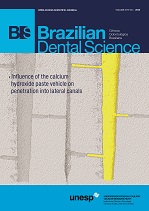Mineral exchange between dentin pre-tretament with Dolomite powder on demineralized dentin in deciduous molars
DOI:
https://doi.org/10.14295/bds.2018.v21i3.1592Abstract
The objective of this study was to evaluate differences in microhardness and mineral profiles in sound and demineralized dentin of primary molars after treatment with powdered dolomite (DMT) followed by glass ionomer cement (GIC) restoration. 32 decidous molars were selected and randomly assigned to four groups according to dentin pre-treatment and dentin condition. Class I cavities were prepared in 32 decidous molars, equally divided into groups G1 (sound dentin) and G2 (demineralized dentin). This in vitro study examined the mechanical and chemical exchange under two conditions: sound and demineralized dentin (pH cycling) to simulate the mineral loss occurs for the caries lesion.The 16-tooth (G1DMT, G2DMT) received first topical application of DMT and restoration of high viscosity GIC. The 16 teeth assigned to the groups (G1 and G2) were restored only with GIC. The specimens were sliced and prepared for Knoop hardness test (KHN), Micro Raman and FEG microhardness analysis. The statiscal analysis used ANOVA and Bonferroni post-test at a significance level of 5%. Micro Raman and FEG data were qualitatively described. DMT associated with GIC resulted incresead microhardness values of the demineralized dentin substrate, with positive repercussions of the chemical-mechanical properties of the dentin demineralized.
Keywords
Dental caries; Dentin; Glass ionomer cement.
Downloads
Downloads
Published
How to Cite
Issue
Section
License
Brazilian Dental Science uses the Creative Commons (CC-BY 4.0) license, thus preserving the integrity of articles in an open access environment. The journal allows the author to retain publishing rights without restrictions.
=================




























